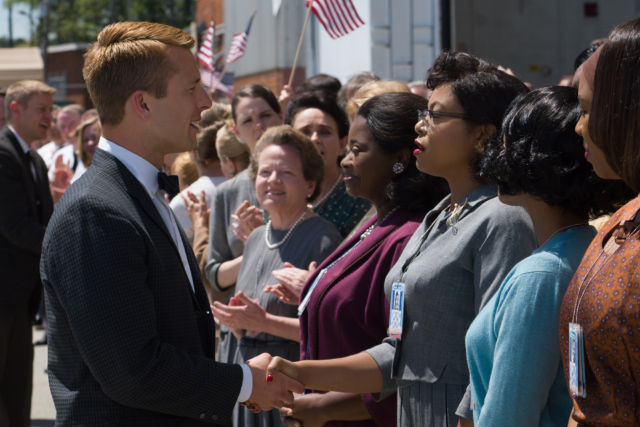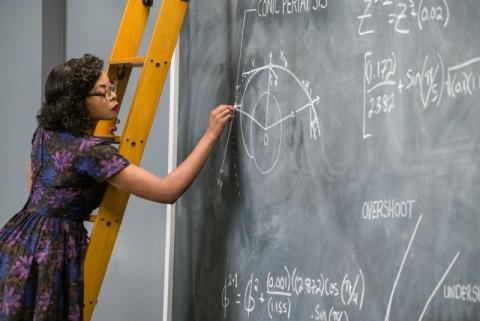There is probably nothing that lifts my spirits more than a movie about heroic scientists sending astronauts into space. Apollo 13 did this masterfully, and The Martian gave it a futuristic twist. And now Hidden Figures has revitalized this quintessentially American tale again, with great success, by focusing on the true story of a group of early NASA mathematicians who plotted Project Mercury’s vehicle flight paths in the 1950s and 60s.
Hidden Figures is the perfect title for this film, based on Margot Lee Shetterly’s exhaustively researched book of the same name. It deals with an aspect of spaceflight that is generally ignored, namely all the calculations that allow us to shoot objects into orbit and bring them back again. But it’s also about the people who are typically offscreen in sweeping tales of the white men who ran the space race. What Hidden Figures reveals, for the first time in Hollywood history, is that John Glenn would never have made it to space without the brilliant mathematical insights of a black woman named Katherine Johnson (played with what can only be called regal geekiness by Taraji Henson from Empire and Person of Interest).
Johnson was part of a group of “colored computers” at Langley Research Center in Atlanta, black women mathematicians who were segregated into their own number-crunching group. They worked on NASA’s Project Mercury and Apollo 11, and Johnson was just one of several women in the group whose careers made history.
Though Johnson is the main character, we also follow the stories of her friends as Langley pushes its engineers to catch up to the Soviets in the space race. Mary Jackson (a terrific Janelle Monae) wants to become an engineer, and eventually gets a special court order so she can attend classes at an all-white school. Dorothy Vaughan (Octavia Spencer) becomes the first African-American woman to lead a department at the space agency, by teaching herself FORTRAN and learning to program Langley’s new IBM mainframe. One of my favorite scenes is when Vaughan debugs the computer for a bunch of white guys who have no idea what’s going on. As they splutter in confusion, she pats the giant, humming mainframe and says, “Good girl.”
In some ways, racial identity is irrelevant to this story about how Project Mercury put the American man into orbit. Like every other brilliant mathematician or scientist on the project, Johnson is putting in long nights and puzzling over thick booklets of figures. She’s under immense pressure trying to come up with the exact calculations to make the famous “go-no-go” orbital flight trajectory work. But unlike her exclusively white colleagues, Johnson faces additional challenges.
One of the most powerful scenes in the film comes after we’ve watched Johnson race half a mile across the Langley campus every day, just so that she can use the only “colored” restroom for ladies. While all the other people in her office can use the facilities right down the hall, she’s told in no uncertain terms that she must use the facilities for black ladies. And that means running fifteen minutes in high heels there and back, rain or shine.
This seems like a minor issue, especially when compared to the fact that Johnson was told that women couldn’t come to mission briefings, even though her work was key to Project Mercury. But the genius of Hidden Figures is that it makes you feel keenly how racism is a series of small insults that pile up every day, little by little, until even a brilliant mathematician is on the verge of going nuts. By the time Johnson delivers an enraged speech to her boss Al Harrison—who has gotten pissy that she always takes 30-minute bathroom breaks—her wrath feels completely earned. Some of her colleagues clearly agree. Harrison (a laconic Kevin Costner, who seems to specialize in playing space mission leaders) immediately bans “colored” restrooms, and he soon starts bringing Johnson to mission briefings too.

Johnson and her colleagues from the "colored computers" group meet the charming John Glenn. 20th Century Fox
Glenn was a big supporter of Johnson too, and at one point he refuses to start his mission until Johnson has checked over all the flight trajectories. Like Harrison, he respects Johnson for her brilliance and doesn’t seem to care that she’s not a white guy. What makes this a satisfying story of overcoming tough odds is that we get a pretty nuanced view of how white people at Langley responded to working with black women—some are unfazed by it, while others are deeply prejudiced and try to thwart the “colored computers” at every turn. And there are no false notes of sister bonding between the white and black women at Langley. In fact, the white women are among the most rejecting when it comes to the aspirations of Johnson and her colleagues.
At its heart, Hidden Figures is a space race movie, and there are terrifically tense moments as Johnson sneaks into mission control (no women allowed, of course) to hear Glenn's triumphant whoop as he makes it through re-entry without cooking to death. But this film manages to bring pulse-pounding excitement even into chalkboard drawings of orbital insertion points. Perhaps the only disappointing part of the film, at least for this space nerd, was that we never got a cool description of Johnson’s great insight that made the mission possible. Yes, we hear about Euler’s rule, but which one? I wanted just a little more.
Still, that’s a pretty minor flaw in an otherwise genuinely fun movie about how science and math can uplift humanity as individuals and as a species. The movie is both an argument for meritocracy and a clear-eyed examination of what happens when we fail to achieve it because of irrational prejudice. Hidden Figures captures a fascinating moment in American history, when the US was putting humans in space, and the civil rights movement was putting people of color on center stage politically. Both achievements were firsts, and both changed the trajectory of history in ways that still affect us today.
At a time of great uncertainty in the United States, Hidden Figures is the perfect balm. It offers an optimistic view of how great this country can be when we unite behind a common cause. And it’s a fun space adventure to boot.


Spread the word